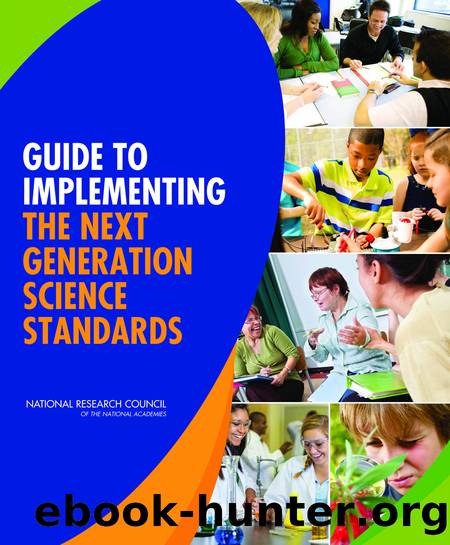Guide to Implementing the Next Generation Science Standards by Committee on Guidance on Implementing the Next Generation Science Standards

Author:Committee on Guidance on Implementing the Next Generation Science Standards
Language: eng
Format: epub
Publisher: The National Academies Press
Published: 2015-04-01T00:00:00+00:00
PITFALLS TO AVOID
Underestimating the Shift Needed in Oneâs Own Practice
Teachers, administrators, and professional development providers who view the Framework and the NGSS through the lens of current practice may underestimate the need for change (Spillane et al., 2002). For example, physics teachers may consider their students are already learning engineering by building and testing model bridges or conducting egg-drop contests. However, these activities do not necessarily represent the NGSS-aligned engineering instruction unless they have been carefully designed to incorporate engineering practices (such as defining problems in terms of criteria and constraints) and involve students in building, extending, or using scientific concepts as part of the engineering project (such as forces or transfer of energy). Similarly, many teachers or administrators may see the science and engineering practices as essentially equivalent to âinquiryâ with just a new name or equivalent to teaching âthe scientific methodâ (Reiser, 2013; Windschitl et al., 2008). Such views miss the NGSSâs emphases on knowledge building, social interaction and discourse, analysis, and reasoning as part of scientific and engineering practices.
It will be easy to underestimate the degree of change in instructional practice needed in order to engage students in the practices of science and engineering. Existing activities for students may have the appearance of engagement in a science or engineering practice because they are hands on or involve students designing experiments, but they may miss the critical aspects of building and testing explanatory ideas.
Some elements of the Framework and the NGSS are already being implemented in some classrooms. Indeed, the vision of the Framework and the NGSS is built on a firm foundation of classroom-based research about what is most effective for science learning. However, few classrooms have been implementing the full range of practices. In addition, the sequencing of core ideas across grades requires some rethinking of what is taught when. Simply doing a check-the-box alignment of old standards, curricula, curriculum materials, or assessment tasks that matches them to pieces of the new standards will not be sufficient for implementing the vision embodied in the NGSS.
Download
This site does not store any files on its server. We only index and link to content provided by other sites. Please contact the content providers to delete copyright contents if any and email us, we'll remove relevant links or contents immediately.
Barron's AP Biology by Goldberg M.S. Deborah T(3654)
Aliens by Jim Al-Khalili(2410)
MCAT Physics and Math Review 2019-2020 by Kaplan Test Prep(1458)
Cracking the AP Physics C Exam, 2018 Edition by Princeton Review(1417)
The Two Cultures by C. P. Snow(1043)
Biology For Dummies (For Dummies (Math & Science)) by Rene Fester Kratz(1035)
Biology For Dummies by Fester Kratz Rene(1033)
Cracking the AP Chemistry Exam, 2012 Edition by Princeton Review(997)
500 AP Chemistry Questions to Know by Test Day(997)
MCAT Organic Chemistry Review 2019-2020 by Kaplan Test Prep(988)
MCAT General Chemistry Review 2019-2020 by Kaplan Test Prep(948)
Cracking the AP Physics 2 Exam, 2018 Edition by Princeton Review(938)
Cracking the AP Chemistry Exam, 2018 Edition by Princeton Review(911)
Aliens: The World's Leading Scientists on the Search for Extraterrestrial Life by Jim Al-Khalili(886)
500 AP Chemistry Questions to Know by Test Day by Mina Lebitz(879)
Chemistry Essentials For Dummies by John T. Moore(841)
McGraw-Hill Education SAT Subject Test Biology by Stephanie Zinn(835)
Cracking the AP Environmental Science Exam, 2018 Edition by Princeton Review(815)
McGraw-Hill Education Preparation for the GED Test by McGraw-Hill Education Editors(799)
